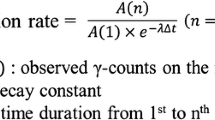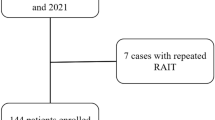Abstract
Purpose
Recombinant human TSH (rhTSH) is used to increase radioiodine uptake during imaging of thyroid cancer, obviating the need to render the patient hypothyroid. We assessed the reproducibility of radioiodine uptake, serum thyrotropin (TSH), and stimulated serum thyroglobulin (Tg) levels after rhTSH administration.
Methods
A retrospective review was performed of patients at Stanford who underwent whole-body 131I scanning for surveillance of thyroid cancer twice after thyroidectomy and 131I ablation, with rhTSH prior to each scan. Forty-eight hour radioiodine uptake, peak serum TSH, and stimulated serum Tg levels for each study were recorded. Paired t tests and correlation analysis were used to assess interexamination repeatability.
Results
Twenty-three patients underwent two scintiscans with rhTSH, for a total of 46 exams. There was no significant difference between percent uptake at 48 h in the paired exams (p=0.40). Serum TSH level was measured in 45 of 46 exams; TSH exceeded 50 mIU/l in all cases, and there was no significant difference between paired TSH levels (p=0.93). All patients had stimulated serum Tg levels measured, with no significant difference between paired Tg levels (p=0.40); after excluding one patient whose Tg changed from 15.8 ng/ml to undetectable between scans without interval treatment, the p value rose to 0.95. There was a strong correlation among paired uptake values (r=0.85, p<0.0001), peak serum TSH (r=0.69, p=0.0003), and stimulated Tg levels (r=0.81, p<0.0001). No discordant scan interpretations were reported.
Conclusion
Forty-eight hour radioiodine uptake, peak serum TSH, and stimulated serum Tg levels after administration of rhTSH are repeatable between studies, demonstrating reproducibility of diagnostic results without rendering patients hypothyroid.



Similar content being viewed by others
References
Mazzaferri E, Jhiang SM. Long-term impact of initial surgical and medical therapy on papillary and follicular thyroid cancer. Am J Med 1994;97:418–28.
Mazzaferri EL. Long-term outcome of patients with differentiated thyroid carcinoma: effect of therapy. Endocr Pract 2000;6:469–76.
Schlumberger M. Papillary and follicular thyroid carcinoma. N Engl J Med 1998;338:297–306.
Cohen JB, Kalinyak JE, McDougall IR. Modern management of differentiated thyroid cancer. Cancer Biother Radiopharm 2003;18:689–705.
Mandel SJ, Shankar LK, Benard F, Yamamoto A, Alavi A. Superiority of iodine-123 compared with iodine-131 scanning for thyroid remnants in patients with differentiated thyroid cancer. Clin Nucl Med 2001;26:6–9.
Cohen JB, Kalinyak JE, McDougall IR. Clinical implications of the differences between diagnostic 123I and post-therapy 131I scans. Nucl Med Commun 2004;25:129–34.
Ladenson PW, Braverman LE, Mazzaferri EL, Brucker-Davis F, Cooper DS, Garber JR, et al. Comparison of administration of recombinant human thyrotropin with withdrawal of thyroid hormone for radioactive iodine scanning in patients with thyroid carcinoma. N Engl J Med 1997;337:888–96.
Haugen BR, Pacini F, Reiners C, Schlumberger M, Ladenson PW, Sherman SI, et al. A comparison of recombinant human thyrotropin and thyroid hormone withdrawal for the detection of thyroid remnant or cancer. J Clin Endocrinol Metab 1999;84:3877–85.
Durski JM, Weigel RJ, McDougall IR. Recombinant human thyrotropin (rhTSH) in the management of differentiated thyroid cancer. Nucl Med Commun 2000;21:521–8.
Ladenson PW. Recombinant thyrotropin for detection of recurrent thyroid cancer. Trans Am Clin Climatol Assoc 2002;113:21–30.
McDougall I, Weigel RJ. Recombinant human thyrotropin in the management of thyroid cancer. Curr Opin Oncol 2001;13:39–43.
Becker D, Charkes ND, Hurley JR, McDougall IR, Price DC, Royal HD, et al. Society of Nuclear Medicine Procedure Guideline for thyroid scintigraphy, version 2.0. Accessible online at http://interactive.snm.org/docs/pg_ch05_0403.pdf. Accessed 6/7/2006.
Cooper DS, Doherty GM, Haugen BR, Kloos RT, Lee SL, Mandel SJ, et al. Management guidelines for patients with thyroid nodules and well-differentiated thyroid cancer. Thyroid 2006;16:109–42.
Hay ID, Thompson GB, Grant CS, Bergstralh EJ, Dvorak CE, Gorman CA, et al. Papillary thyroid carcinoma managed at the Mayo Clinic during six decades (1940–1999): temporal trends in initial therapy and long-term outcome in 2444 consecutively treated patients. World J Surg 2002;26:879–85.
Dow K, Ferrell BR, Anello C. Quality-of-life changes in patients with thyroid cancer after withdrawal of thyroid hormone therapy. Thyroid 1997;7:613–9.
Schroeder PR, Haugen BR, Pacini F, Reiners C, Schlumberger M, Sherman SI, et al. A comparison of short-term changes in health-related quality of life in thyroid carcinoma patients undergoing diagnostic evaluation with recombinant human thyrotropin compared with thyroid hormone withdrawal. J Clin Endocrinol Metab 2006;91:878–84.
Park H, Perkins OW, Edmondson JW, Schnute RB, Manatunga A. Influence of diagnostic radioiodines on the uptake of ablative dose of iodine-131. Thyroid 1994;4:49–54.
McDougall IR. 74 MBq radioiodine 131I does not prevent uptake of therapeutic doses of 131I (i.e. it does not cause stunning) in differentiated thyroid cancer. Nucl Med Commun 1997;18:505–12.
Luster M, Sherman SI, Skarulis MC, Reynolds JR, Lassman M, Hanscheid H, et al. Comparison of radiobiokinetics following the administration of recombinant human thyroid stimulating hormone and after thyroid hormone withdrawal in thyroid carcinoma. Eur J Nucl Med Mol Imaging 2003;30:1371–7.
Author information
Authors and Affiliations
Corresponding author
Additional information
Disclosures
No funding was received for the completion of this study. Neither author claims any financial relationship or conflict of interest with any of the material presented. The authors have had full control of primary data, and allow the EJNMMI to review the data if requested.
Rights and permissions
About this article
Cite this article
Niederkohr, R.D., McDougall, I.R. Reproducibility of whole-body 131I scan and serum thyrotropin and stimulated thyroglobulin values in patients studied twice after injection of recombinant human thyrotropin. Eur J Nucl Med Mol Imaging 34, 363–367 (2007). https://doi.org/10.1007/s00259-006-0227-y
Received:
Accepted:
Published:
Issue Date:
DOI: https://doi.org/10.1007/s00259-006-0227-y




